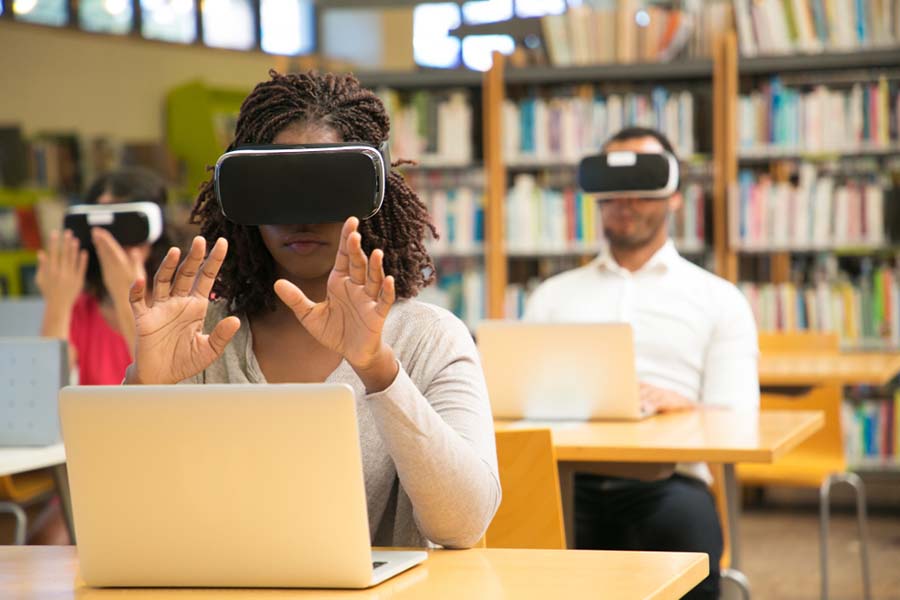Metaverse Education: Virtual Learning Unleashed

The advent of technology has revolutionised the way we learn and educate ourselves. With the rise of the metaverse, a virtual reality-based digital universe, the possibilities for education have expanded exponentially. In this blog, we will explore the concept of metaverse education and its impact on virtual classrooms, training, and learning experiences.
Understanding the Metaverse
The metaverse refers to a collective virtual shared space where individuals can interact with a computer-generated environment and other participants in real time. It encompasses various digital realities, including virtual reality (VR), augmented reality (AR), and mixed reality (MR).
Virtual reality (VR) creates a fully immersive experience by simulating a three-dimensional environment, allowing users to interact with and explore the virtual world. Augmented reality (AR) overlays digital content in the real world, enhancing users’ perception and interaction with their surroundings. Mixed reality (MR) combines elements of both VR and AR, enabling users to interact with virtual and real objects simultaneously.
Virtual Classrooms in the Metaverse
Virtual classrooms in the metaverse offer a unique and immersive learning experience. Students and teachers can join a virtual environment that mimics a physical classroom with interactive features and tools. These virtual classrooms allow for real-time collaboration, communication, and engagement, transcending geographical limitations.
Benefits of Virtual Classrooms
Accessibility: Virtual classrooms break down barriers to education, enabling learners from remote areas or with physical disabilities to access quality education. Students with limited access to educational resources can now participate in virtual classrooms from the comfort of their homes.
Engagement: The interactive nature of virtual classrooms promotes active learning, as students can manipulate objects, participate in simulations, and engage with multimedia content. This hands-on approach enhances comprehension and retention of information.
Personalisation: Metaverse education allows for personalised learning experiences, catering to individual student needs and preferences. Through adaptive learning algorithms, virtual classrooms can adapt the curriculum and teaching methods to suit each student’s learning style, pace, and interests.
Collaborative Learning: Virtual classrooms foster student collaboration through group activities, discussions, and shared projects, enhancing teamwork and social interaction. Students can work together in real-time, regardless of physical location, promoting community and collective learning.
Cost-Effectiveness: Implementing virtual classrooms reduces the need for physical infrastructure, textbooks, and travel expenses, making education more affordable. This cost-effective approach makes quality education accessible to a broader range of individuals, levelling the playing field for students from diverse backgrounds.
Training in the Metaverse: A Paradigm Shift
The metaverse also offers unparalleled opportunities for professional training and development. Companies and organisations can leverage immersive technologies to create simulated environments that replicate real-world scenarios for training purposes. This approach, known as virtual training, provides a safe and controlled environment for employees to practice skills and gain expertise.
Advantages of Virtual Training
Risk-Free Environment: Virtual training allows users to make mistakes and learn from them without real-world consequences, facilitating skill acquisition and confidence-building. Employees can experiment and refine their techniques in a safe and controlled setting, ensuring they are well-prepared for real-world challenges.
Cost-Efficiency: Compared to traditional training methods, virtual training eliminates the need for physical resources, travel expenses, and instructor fees, resulting in significant cost savings. Companies can train a large number of employees simultaneously without incurring additional expenses.
Scalability: Virtual training can be easily scaled to accommodate many trainees simultaneously, ensuring consistent and standardised training experiences. This scalability allows organisations to efficiently train their workforce without compromising the quality of the training program.
Remote Accessibility: Geographical barriers are eliminated, enabling employees from different locations to participate in the same training program, ensuring uniformity and inclusivity. Remote employees can receive the same level of training as their on-site counterparts, fostering a sense of equality and cohesion within the organisation.
Real-Time Feedback: Virtual training platforms can provide instant feedback and performance evaluations, allowing learners to track their progress and identify areas for improvement. This immediate feedback loop enables employees to continuously enhance their skills and ensure continuous professional growth.
Learning Experiences Transformed
Metaverse education redefines traditional learning experiences by offering a more immersive and engaging environment for students of all ages. It introduces cutting-edge technologies that enhance learning, making it more interactive, visually appealing, and memorable.
Key Elements of Enhanced Learning Experiences
Gamification: Gamifying educational content in the metaverse adds an element of fun and competition, motivating learners to participate and achieve learning objectives actively. By introducing game-like elements, such as leaderboards, badges, and rewards, students are incentivised to engage with the material and strive for mastery.
Multimedia Integration: Integrating multimedia elements such as videos, 3D models, and interactive quizzes enhances comprehension and retention of information. Visual and auditory aids help learners visualise abstract concepts, making complex topics more accessible and engaging.
Virtual Excursions: Through the metaverse, students can embark on virtual excursions to historical sites, museums, or outer space, providing an immersive and enriched learning experience. These virtual field trips allow students to explore places they may have yet to have the opportunity to visit physically, broadening their horizons and deepening their understanding of the subject matter.
Simulations and Experiments: Metaverse education enables students to engage in realistic simulations and experiments, allowing them to apply theoretical knowledge in practical scenarios. For example, physics students can conduct virtual experiments to observe the laws of motion, fostering a deeper understanding of the concepts through hands-on exploration.
Adaptive Learning: With the help of artificial intelligence, metaverse education can adapt to individual student needs, providing tailored learning paths and personalised feedback. AI algorithms can analyse students’ performance and learning styles to deliver customised content, ensuring each student receives the support and guidance required to succeed.
The Future of Metaverse Education
As technology continues to advance, the potential for metaverse education is boundless. Integrating artificial intelligence, machine learning, and virtual reality will enhance the educational experience, making it even more immersive, interactive, and personalised.
Conclusion
Metaverse education has transformed the way we teach and learn. Virtual classrooms offer accessible, engaging, cost-effective learning environments, while virtual training provides safe, scalable, and efficient professional development opportunities. With enhanced learning experiences and continuous technological advancements, metaverse education is poised to shape the future of education in exciting and unprecedented ways.
Be sure to check out our other related posts if you enjoyed this one:
- The Rise of Collaborative Robots: Transforming Industries
- Unmasking Cyber Secrets: The Art of Deception Revealed!
- Decoding Cyber Threats: The Social Engineering Menace
- Unlock the Ultimate Quest: Ready Player One’s Audio Adventure!
- Revolutionising Wellness: Metaverse Therapy Unleashes Mental Liberation!
- Code Mastery Unleashed: Transform Your Skills with Clean Code by Robert C. Martin! 🚀
- Top Must-Have Tech Gadgets for Kids – Unbelievable Fun!
- Mastering Crypto Trading: Proven Strategies
- Unveiling Ethereum 2.0: Advancements & Impact
- AI Transforms E-Commerce: A Digital Revolution
Sign up for updates on this blog and our latest posts if you enjoyed reading this one.
FAQ
What is the metaverse?
The metaverse refers to a collective virtual shared space where individuals can interact with a computer-generated environment and other participants in real time. It encompasses various digital realities, including virtual reality (VR), augmented reality (AR), and mixed reality (MR).
What are the benefits of virtual classrooms in the metaverse?
Virtual classrooms in the metaverse offer accessibility, engagement, personalisation, and collaborative learning. They break down barriers to education, promote active learning, cater to individual student needs, and foster collaboration among students.
How does virtual training in the metaverse benefit organisations?
Virtual training in the metaverse provides a risk-free environment for employees to practice skills, resulting in skill acquisition and confidence-building. It is cost-efficient, scalable, allows remote accessibility, and provides real-time feedback and performance evaluations.
How does metaverse education enhance learning experiences?
Metaverse education enhances learning experiences through gamification, multimedia integration, virtual excursions, simulations and experiments, and adaptive learning. It adds an element of fun and competition, enhances comprehension, provides immersive experiences, allows for the practical application of knowledge, and delivers personalised learning paths.
Credits
Featured image by pch.vector on Freepik.









